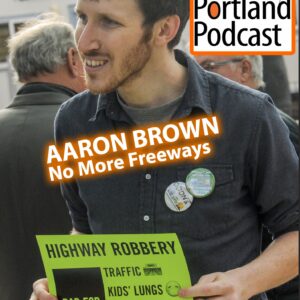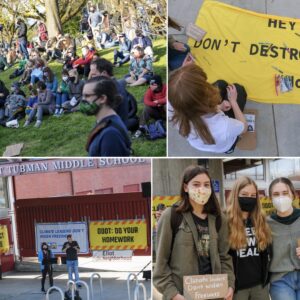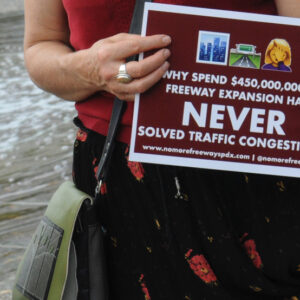
It’s a huge day for Portland transportation reformers who want Oregon to more quickly adapt to a future where freeway expansions don’t happen and we finally break off our dysfunctional relationship with cars.
Activists who’ve spent years fighting against the negative impacts of our region’s car overuse problem woke up to a major story in the New York Times that gave their positions and opinions a national platform. To make it even better for them, the venerable news source framed their story around a question, “Can Portland Be a Climate Leader Without Reducing Driving?” that isn’t much different than the main tagline of local nonprofit No More Freeways: “Climate leaders don’t widen freeways.”
Also this morning was a meeting of the Interstate Bridge Replacement Program where project leaders outlined the Locally Preferred Alternative to elected officials from around the region. One of them, Portland Bureau of Transportation Commissioner Jo Ann Hardesty picked apart their presentation and assumptions and offered some of her sharpest opposition yet to the project (full story in a few minutes). And that was Hardesty’s second meeting of the day. She was up early for Metro’s Joint Policy Advisory Committee on Transportation where she expressed discomfort about ODOT’s plan to toll I-205 and use the money to invest in more freeways.
Advertisement
And as I type this, President Joe Biden is making his way to the Portland Yacht Club on Northeast Marine Drive where he’ll talk up infrastructure projects against the backdrop of the Interstate Bridge. There’s widespread expectation he’ll make an announcement about the project that will expand five miles of I-5 between Portland and Vancouver.
And right as President Biden wraps up his speech, youth activists organized by No More Freeways and Sunrise PDX will gather for another rally at Harriet Tubman Middle School, a school so impacted by the nearby presence of I-5 they had to install an expensive air filtration system and are not permitted to play outside on some days due to toxins in the air spewed from the mufflers of passing cars and trucks.
This inspiring Youth vs ODOT rally has gained considerable strength since we first met them back in June of last year (see the video above). Seeing one of their leaders’ photographs in the New York Times will only serve to build their movement.
Just like the persistent problem they are fighting against, this anti-freeway movement will not go away until something changes. The sooner the powers-that-be realize that, and the sooner they understand that the answer to the NY Times’ question is a resounding “No!”, the better off we will all be.






Thanks for reading.
BikePortland has served this community with independent community journalism since 2005. We rely on subscriptions from readers like you to survive. Your financial support is vital in keeping this valuable resource alive and well.
Please subscribe today to strengthen and expand our work.
“…Over the past few decades, Oregon’s largest city has built an extensive light rail system, added hundreds of miles of bike lanes…”
Got to laugh. We can’t use our bike paths as they have been turned over to the homeless. How does that impact our climate goals?
Bike paths are not bike lanes. The article clearly says bike lanes.
Homelessness is a problem yes, but there is no easy solution. Honestly, this is a shared problem in where we are all complicit in taking part in a system that literally drives people crazy and marginalizes others. Until we as a culture stop going to the church of acquiring limitless goods for as cheap as possible, this problem will just get worse. I think we got what we deserve here and if our bike paths provide a space where these people feel more safe with a sense of privacy, I say we should work with them to make sure they aren’t at least blocking the path and run periodic cleanups to prevent the garbage pileups.
Yeah, my ordering a nick-nack from an online retailer is the reason for the dozen or so unhealthy campers near my house with their piles of trash.
Homelessness is complex and has many facited sides but ultimately it has a lot to do with the person that makes the choice to stay camping, stay drug addicted, stay booze addicted, etc. That’s not to say there shouldn’t be facilities to help those that want help, but unfortunately as a society (and I was guilty in the early months too) of not doing anything meaningful.
We thought by giving the County and City wheelbarrow fulls of tax money they’d do something. They are too busy waffling and trying to find the perfect solution. There is NO PERFECT SOLUTION. I’ve given up that they’ll do anything productive.
So as a citizen of this City, I’ve given up. Yes, just plane given up on this whole mess. I will no longer donate money or goods. I will no longer support any causes. I’m tired. I’m frustraited.
Will I ignore them, nope. I’ve had many a conversation with folks while out taking walks and will continue to do so. But other than that I’m done and will continue to get my nick-nacks online.
https://t.co/LN7ysOnYjL
A lot are fine with their current situation… Hard to force people to get in housing even if it was provided.
Our Million dollar homeless bond is just wasted money if you don’t understand the problem.
Ah right, great distinction to make, because those hundreds of miles of bike lanes definitely aren’t strewn with trash and debris, much less located directly adjacent to traffic that we are no longer able to enforce the controlling laws of.
If the only solution to homelessness is to provide housing with no requirement for cessation of drug use or treatment of mental health, yeah, there is no easy solution because the bar has been placed so high that the cost to everyone else will be beyond excessive. However, if you’re actually interested in or believe that there are options available that do not suggest that living alongside a bike path to be a space they feel “more safe with a sense of privacy”, we could actually improve our public spaces for everyone who pays for them to use, provide better housing (both temporary and permanent), and services to improve the lives of the homeless. Under no scenario should we be catering to people who just want to live on the street, do drugs and not have any responsibility for their life and the impact it has on everyone else. We are perpetually concerned about the most “vulnerable” among us, but here in Portland we may be one of the best at keeping them vulnerable rather than making any meaningful changes because it might be hard.
https://t.co/LN7ysOnYjL
You need to talk homeless people…
Re: “currently under construction” – it’s a bit late to protest about Hwy 217 now.
It’s not too late to stop the I-5 expansions.
Extending the highways won’t increase the number of cars on them. They’re being increased becuase of the number of cars on them currently is too many for the highway to handle, leading to slow traffic and cars barely moving while burning thru fuels inefficently.
If you look more into this, you may be surprised by what you find.
Cars are a horribly inefficient way to move large numbers of people, unfortunately most American cities have done a terrible job giving us a better option. Doubling down on car infrastructure will never be the solution, we have been trying for decades and yet commute times have barely budged. I recently spent some time in Texas and experienced what full commitment to the car looks like. Even in the liberal bastion of Austin the freeways were gigantic, hundreds of yards across, lined with toll lanes, circled by ramps in every direction, and there was still heavy traffic, on a Sunday.
The fact that DOT does not “consider[] induced traffic demand when planning new highways” tells you everything that is wrong with the agency and the Governor.